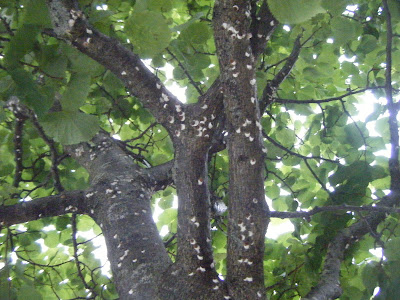 |
| Horse Chestnut Scale, Pulvinaria regalis |
While I have previously written on this blog that scale insects tend to be quite small, a large example has recently come to my attention. Pulvinaria regalis, or the Horse Chestnut Scale, is c. 6 mm in diameter, and the female is particularly visible this time of year when they produce a large, white, fluffy, ovisac into which up to 2,000 eggs are layed (1). Upon laying the eggs, the female dies, but remains attached to the ovisac as a protective shield. Without the ovisac, Pulvinaria regalis is excellently camouflaged against the bark of its hosts, Horse Chestnut, Linden and Elm species (its many hosts making it polyphagus), where it feeds by extraction of sap. Once the young hatch, they are easily dispersed by the wind due to their small size (2)
 |
| Horse Chestnut Scale, Pulvinaria regalis |
P. regalis is thought to be of asian origin, and was first recorded in Europe in 1968 (2). The first record for Ireland was as recent as 2000 on a horse chestnut tree in Dublin, and the authors speculated then that P. regalis may spread throughout the country (3). This has proved to be the case as shown by this sighting in Cork city.
 |
| Horse Chestnut Scale, Pulvinaria regalis on Linden Tree |
P. regalis is a particularly urban insect in Ireland, and Britain, where its host plants are not native (2). It rarely causes significant damage to trees, proving to be just rather unsightly.
References:
References:
- Speight and Nicol, 1985. Antenna 9 pp. 175–178
- Speight et al., 1998. Ecology 79 pp. 1503-151
- O'Connor and Fox, 2000. Entomologist's Gazette 51 pp. 145-146
No comments:
Post a Comment